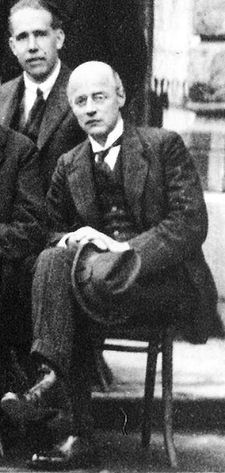- Owen Willans Richardson
-
Owen Willans Richardson
Niels Bohr and Richardson (right) at the 1927 Solvay conferenceBorn 26 April 1879
Dewsbury, Yorkshire, EnglandDied 15 February 1959 (aged 79)
Alton, Hampshire, EnglandNationality United Kingdom Fields Physics Institutions University of Cambridge
Princeton University
King's College LondonAlma mater University of Cambridge
University College, LondonDoctoral advisor J. J. Thomson Doctoral students Karl Taylor Compton
Clinton DavissonKnown for Richardson's Law Notable awards Nobel Prize in Physics (1928)
Hughes Medal (1920)Sir Owen Willans Richardson, FRS (26 April 1879 - 15 February 1959) was a British physicist who won the Nobel Prize in Physics in 1928 for his work on thermionic emission, which led to Richardson's Law.[1]
Contents
Biography
Richardson was born in Dewsbury, Yorkshire, England, the only son of Joshua Henry and Charlotte Maria Richardson. He was educated at Batley Grammar School and Trinity College, Cambridge, where he gained First Class Honours in Natural Sciences.[2]
 Owen Willans Richardson (1934)
Owen Willans Richardson (1934)
After graduating in 1900, he began researching the emission of electricity from hot bodies at the Cavendish Laboratory in Cambridge, and in 1902 he was made a fellow at Trinity. In 1901, he demonstrated that the current from a heated wire seemed to depend exponentially on the temperature of the wire with a mathematical form similar to the Arrhenius equation. This became known as Richardson's law: "If then the negative radiation is due to the corpuscles coming out of the metal, the saturation current s should obey the law
 ."[3]
."[3]Richardson was professor at Princeton University from 1906 to 1913, and returned to the UK in 1914 to become Wheatstone Professor of Physics at King's College London, where he was later made director of research. He retired in 1944, and died in 1959.
He also researched the photoelectric effect, the gyromagnetic effect, the emission of electrons by chemical reactions, soft X-rays, and the spectrum of hydrogen.
Richardson married Lilian Wilson, sister of his Cavendish colleague Harold Wilson, in 1906, and had two sons and a daughter. Richardson's own sister married the American physicist (and 1937 Nobel laureate) Clinton Davisson, who was Richardson's PhD student at Princeton. After Lilian's death in 1945, he was remarried in 1948 to Henriette Rupp, a physicist.
Honours
Richardson became a Fellow of the Royal Society in 1913, and was awarded its Hughes Medal in 1920. He was awarded the Nobel Prize in Physics in 1928, "for his work on the thermionic phenomenon and especially for the discovery of the law named after him".[4] He was knighted in 1939.
References
- ^ Nobel Foundation (1928). "Owen Willans Richardson: The Nobel Prize in Physics 1928". Les Prix Nobel. http://www.nobel.se/physics/laureates/1928/richardson-bio.html. Retrieved 2007-09-17.
- ^ Richardson, Owen Willans in Venn, J. & J. A., Alumni Cantabrigienses, Cambridge University Press, 10 vols, 1922–1958.
- ^ Proceedings of the Cambridge Philosopical Society, quoted in
- ^ Nobel prize citation, Nobel foundation website
Bibliography
- Richardson, OW (1921), "Problems Of Physics", Science 54 (1396): 283–91, 1921 Sep 30, Bibcode 1921Sci....54..283R, doi:10.1126/science.54.1396.283, PMID 17818864
- Richardson, OW (1913), "The Emission Of Electrons From Tungsten At High Temperatures: An Experimental Proof That The Electric Current In Metals Is Carried By Electrons", Science 38 (967): 57–61, 1913 Jul 11, Bibcode 1913Sci....38...57R, doi:10.1126/science.38.967.57, PMID 17830216
- Richardson, OW (1912), "The Laws Of Photoelectric Action And The Unitary Theory Of Light (Lichtquanten Theorie)", Science 36 (915): 57–8, 1912 Jul 12, Bibcode 1912Sci....36...57R, doi:10.1126/science.36.915.57-a, PMID 17800821
- Richardson, OW; Compton, KT (1912), "The Photoelectric Effect", Science 35 (907): 783–4, 1912 May 17, Bibcode 1912Sci....35..783R, doi:10.1126/science.35.907.783, PMID 17792421
External links
Nobel Laureates in Physics (1926–1950) Perrin (1926) · Compton / C. Wilson (1927) · O. Richardson (1928) · De Broglie (1929) · Raman (1930) · Heisenberg (1932) · Schrödinger / Dirac (1933) · Chadwick (1935) · Hess / C. D. Anderson (1936) · Davisson / Thomson (1937) · Fermi (1938) · Lawrence (1939) · Stern (1943) · Rabi (1944) · Pauli (1945) · Bridgman (1946) · Appleton (1947) · Blackett (1948) · Yukawa (1949) · Powell (1950)
Complete list · (1901–1925) · (1926–1950) · (1951–1975) · (1976–2000) · (2001–2025) Categories:- 1879 births
- 1959 deaths
- Academics of King's College London
- Alumni of Trinity College, Cambridge
- British Nobel laureates
- English theoretical physicists
- Fellows of King's College London
- Fellows of the Royal Society
- Knights Bachelor
- Nobel laureates in Physics
- Old Batelians
- People from Dewsbury
- Princeton University faculty
- Royal Medal winners
- Presidents of the Physical Society
Wikimedia Foundation. 2010.

